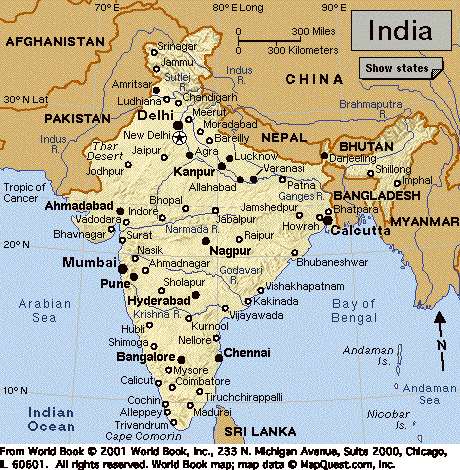I. Tarlo and "The Problem of What to Wear"
A. Clothing Matters: the "problem of what to wear" in India, 19th-20th c.
B. Three processes of dress1. Classification: group membership, fitting in, distinguishing oneselfC. British colonialism disrupted classification, identification, and communication
2. Identification: clothes express allegiance to group(s)
3. Communication: messages can be ambiguous, confusing, open to multiple interpretations
II. The Great Transformation: The Consumer Revolution in England (McCracken)
A. Elizabethan England (last quarter of the 16th century)1. Queen Elizabeth I: lavish court expenditures and displaysB. 18th century
2. Nobles compete in conspicuous consumption1. Consumerism spreads to rest of populationC. 19th century
2. Number and availability of goods increases
3. Fashion1. Consumer revolution is entrenched
2. Department stores: get goods, learn about consumption possibilities
3. Consumption as self-expression
III. British Colonialism, Industrialization, and Consumption
A. McCracken doesn't tell us where goods come from and why affordable: colonialism and industrialization
B. Colonialism (c. 1500 - 1970s): Three stages1. Exploration (late 15th-mid 17th centuries)C. World Wars and Russian Revolution destabilize coloniesa. Outposts in America, Africa, and Asia2. Mercantilism (17th century and 18th centuries)
b. Late 1400s: Portuguese explore southern Africa toward India
c. Spanish conquistadors in North and South America
d. French in Canada in 17th century
e. English in North America
f. Tensions between Spain and Britain during Queen Elizabeth I's reigni. Spanish blockade West Indies
ii. British ships smuggle African slaves to West Indies
iii. British pirates plunder Spanish ships, share booty with Queen Elizabeth
iv. 1588: Spanish armada attacks Britain, loses
v. Britain becomes major seafaring and commercial powera. Theory3. Imperialism (late 18th-mid 20th century)i. National wealth is measured by gold and silverb. British East India Company
ii. Colonies exist to benefit the mother country, help achieve profit
iii. Mother country gets raw materials, sells colonies finished products
iv. Monopolistic tradei. Joint stock company formed in 1600c. French establish presence in India
ii. Arrives in Surat, India in 1608:
iii. Establishes trading posts: Gujarat (1612), Chennai (Madras) (1640), Mumbai (Bombay) (1668), Calcutta (1690)a. Adam Smith's laissez-faire philosophy: free trade better than monopolies
b. Industrial Revolution starts in England in 1760s
c. Industrial nations want to expand markets for manufactured goods
d. Colonies supply industrial raw materials and food
e. Imperialist economic policiesi. Land-holding: private property, European acquisition, plantationsf. Direct rule, new legal codes, cultural assimilation, military force
ii. Cheap wage labor for commercial agriculture and mining
iii. Encourage spread of money and commodities, money payments for taxes, land rents
iv. Block native production and exportsi. French kicked out of Indiag. Imperialism accelerates, late 19th-early 20th centuries
ii. East India Company rules country until Rebellion of 1857
iii. 1858: Britain begins direct rule of Indiai. More nations: Germany, the United States, Belgium, Italy, Japan, and Russia
ii. More territory: China (trade zones), Africa
iii. 1914: 85% of Earth's land = colonial powers, colonies, and former colonies
D. India independence: 1947
E. 1950s-1970s: most colonies become independent
F. Correlation between three periods of colonialism and three periods of consumption1. Exploration = Elizabethan courtly consumption
2. Consumer revolution = mercantilism, goods available to more and more classes in Britain because of wealth and raw material extraction from colonies
3. Entrenchment of consumerism = Imperialism, clothing used to distinguish people in colonial settings
IV. British Responses to Indian Dress
A. British as civilized, Indian men as naked and disgraceful: dhoti
B. Gracefulness of Indian men's dress1. Flowing linesC. Civilizing mission
2. Effeminate, Indian men as weak and powerless1. Missionaries distributed saris and respectable Indian clothesD. Goal of British sartorial policies
2. Cloth and clothes increasingly manufactured in England
3. British manufacturers try to conform to traditional Indian tastes, appeal to lower classes
4. British create Indian elites: educate, but keep distincta. Serve as mediators
b. British worry about power of elite Indians
c. Boundary maintenancei. British in India maintain European style: sun helmet, suits, light colors, perfectly pressed and starched clothes
ii. Indian dress regulated at school
iii. "oriental" touches added to military uniforms
iv. Decrees govern Indian dress for ceremonial and official events1. Improve Indian standards of dress
2. Promote consumption of British goods
3. Keep Indians distinct from Europeans, inferior
V. Indian Sartorial Responses to British Rule
A. Indian problems of "what to wear"1. European clothes = civilization, power, and masculinityB. Problems faced by men only, Indian women had to be modest, wear saris
2. Change in clothes = change in culture, risk of alienationa. Sitting on floor
b. Head coverings and issues of respect
c. Shoes: wear inside?
C. Four choices1. Foreign fabrics, traditional stylesD. Dimensions of complicated problem of what to weara. Women wore British manufactured saris2. Combine Indian and European
b. Men Europeanized traditional garments
c. Accepted by other Indians
d. Satisfied British: look Indian, buy English clotha. Popular in cities3. Change clothes according to context
b. British coat over dhoti
c. Ridiculed by British, disdained by other Indiansa. Home = Indian clothes4. Full European dress
b. Work, public spaces = European clothes
c. Strategic move: maximize clothing benefits
d. Changing clothes = inconvenient
e. Early 20th c.: British-educated returnees stopped switching, became Europeanizeda. Suits and turbans
b. British still discriminated against Indians on basis of skin color
c. Indian peers: putting on airs1. Economic: promote British industry, European clothing was expensive
2. Political: boundary maintenance, challenge of boundaries
3. Private decisions


